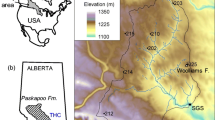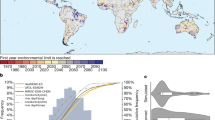Abstract
Climate change in the Great Lakes Basin of North America over the next several decades is projected to lead to significant changes to coastal environments. Groundwater-driven coastal bluff recession should increase in areas where groundwater forcing is important and lead to increased loss of coastal uplands. The latter is an issue in NW Pennsylvania because of coastal development pressures, and because the state ranks within the top five US states in grape production, most of which occurs within 5 km of the Lake Erie coastline. In 2007, viticulture contributed almost $2.4 billion to the state economy. An analysis of a 20-km stretch of coast shows that bluff retreat is pervasive and variable under current climatic conditions. Over a 9-year time frame, bluff change rates ranged from −4.2 to +0.98 m/year. In general, higher retreat rates (−0.2 to −0.65 m/year) occurred along the sandy central beach–ridge sector which lacks significant surface drainage. Lower retreat rates (−0.10 to −0.25 m/year) occurred along coastal sectors where surface drainage networks are well developed. Conservative estimates of groundwater discharge at the bluff correlate strongly (r = 0.74, p < 0.001) with bluff retreat rate. Groundwater is inferred to be the principal driving mechanism for both bluff retreat and spatial variability in retreat rates on this coast. Other common factors that may spatially influence bluff retreat elsewhere (bluff height, land use, beach width) do not correlate strongly with retreat rate.








Similar content being viewed by others
References
Aguilar FJ, Mills JP (2008) Accuracy assessment of LiDAR-derived digital elevation models. Photogramm Rec 23:148–169
Brien DL, Reed ME (2007) Modeling 3-D slope stability of coastal bluffs using 3-D groundwater flow, southwestern Seattle, Washington. USGS Scientific Investigations Report 2007–5092, Reston, 54
Buckwalter TF, Schreffler TL, Gleichsner RE (1996) Geohydrology and water quality of the unconsolidated deposits in Erie County, Pennsylvania. US Geological Survey Water-Resources Investigations Report 95–4165, Denver, 105
Catuneanu O (2006) Principles of sequence stratigraphy. Elsevier, Oxford
Cherkauer S, McKereghan F (1991) Ground-water discharge to lakes: focusing in embayments. Ground Water 29:72–80
ECDPS (2012) 2012 Hazard mitigation plan. Erie County Department of Public Safety, Erie, Pennsylvania, 217. http://www.ecdops.org/. Accessed September 2012
Emery KO, Kuhn GG (1982) Sea cliffs: their processes, profiles, and classification. Geol Soc Am Bull 93:644–654
Fetter CW (2008) Applied hydrogeology, 4th edn. Prentice Hall, USA
Foyle AM, Naber MD (2012) Decade-scale coastal bluff retreat from LiDAR data: Lake Erie coast of NW Pennsylvania, USA. Environ Earth Sci 66:1999–2012. doi:10.1007/s12665-011-1425-x
Foyle AM, Naber MD (2013) Bluff-face groundwater flux as a driver of coastal-zone land loss on the southern Great Lakes coast: a case study from the Pennsylvania coast of Lake Erie, USA. Annual Meeting Program, p 211. Association of American Geographers Annual Meeting, Los Angeles
Foyle AM, Naber MD, Pluta MJ (2011) Short-term bluff retreat behavior along Pennsylvania’s Great Lakes coastline, USA. Eos, Transactions of the American Geophysical Union 92, Fall Meeting Supplement, Abstract NH211B-1510
Hampton MA, Griggs GB (2004) Formation, evolution, and stability of coastal cliffs—Status and trends. US Geological Survey Professional Paper 1693, Denver
Hapke CJ, Reid D (2007) National assessment of shoreline change, part 4: historical coastal cliff retreat along the California coast. US Geological Survey Open-File Report 2007–1133
Hapke CJ, Malone S, Kratzmann M (2009) National assessment of historical shoreline change: a pilot study of historical coastal bluff retreat in the Great Lakes, Erie, Pennsylvania. USGS Open-File Report 2009–1042
Higgins GC, Coates DR (1990) Groundwater geomorphology: the role of subsurface water in earth surface processes and landforms. US Geological Survey Special Paper 252, Boulder
Hodgson ME, Bresnahan P (2004) Accuracy of airborne LiDAR-derived elevation: empirical assessment and error budget. Photogramm Eng Remote Sens 70:331–339
Hodgson ME, Jensen J, Raber G, Tullis J, Davis BA, Thompson G, Schuckman K (2005) An evaluation of LiDAR derived elevation and terrain slope in leaf-off conditions. Photogramm Eng Remote Sens 71:817–823
Holcombe TL, Taylor LA, Reid DF, Warren JS, Vincent PA, Herdendorf CE (2003) Revised Lake Erie postglacial lake level history based on new detailed bathymetry. J Great Lakes Res 29:681–704
Karl TR, Melillo JM, Peterson TC (2009) Global climate change impacts in the United States. Cambridge University Press, Cambridge
Knuth PD (1981) A geotechnical investigation of the coastal bluffs of Erie County, Pennsylvania, 1st edn. Lake Erie Institute for Marine Science, Erie
Komar PD (1998) Beach processes and sedimentation. Prentice Hall, NJ
Laity JE, Malin MC (1985) Sapping processes and the development of theatre-headed valley networks on the Colorado Plateau. Geol Soc Am Bull 96:203–217
Lofgren BM, Quinn FH, Clites AH, Assel RA, Eberhardt AJ, Luukkonen CL (2002) Evaluation of potential impacts on Great Lakes water resources based on climate scenarios of two GCMs. J Great Lakes Res 28:537–554
Lofgren BM, Hunter TS, Wilbarger J (2011) Effects of using air temperature as a proxy for potential evapotranspiration in climate change scenarios of Great Lakes Basin hydrology. J Great Lakes Res 37:744–752. doi:10.1016/j.jglr.2011.09.006
MacEachren AM, Davidson JV (1987) Sampling and isometric mapping of continuous geographic surfaces. Am Cartogr 14:299–320
Maling DH (1989) Measurements from maps. Pergamon Press, New York
Mickelson DM, Edil TB, Guy DE (2004) Erosion of coastal bluffs in the Great Lakes. In: Hampton MA, Griggs GB (eds) Formation, evolution, and stability of coastal cliffs—Status and trends. US Geological Survey Professional Paper 1693, Denver, pp 107–123
NCDC (2013) Climate of Pennsylvania. National Climatic Data Center. http://www.ncdc.noaa.gov/. Accessed October 2012
NOAA-CSC (2013) NOAA Coastal Services Center—Digital Coast. http://www.csc.noaa.gov/digitalcoast/. Accessed March 2013
NRCS (2013) Natural Resources Conservation Service, USDA Web Soil Survey. http://www.nrcs.usda.gov/. Accessed November 2012
PA CRMP (2013) Pennsylvania Coastal Resources Management Program. http://www.dep.state.pa.us/river/czmp.htm. Accessed March 2013
PADEP (2013) Municipal reference document: guidance for the implementation of the chapter 85 bluff recession and setback regulations. Pennsylvania Department of Environmental Protection, Harrisburg
PASDA (2013) Pennsylvania Spatial Data Access. http://www.pasda.psu.edu. Accessed March 2012
Pope J, Stewart CJ, Dolan R, Peatross J, Thompson CL (1999) The Great Lakes: shoreline type, erosion, and accretion. 1:2,000,000-scale map sheet, US Geological Survey, Reston
Richards DG, McCoy HJ, Gallaher JT (1987) Groundwater resources of Erie County, Pennsylvania. Pennsylvania Department of Environmental Resources, Harrisburg
Schooler E (1974) Pleistocene beach ridges of NW PA. PA Geological Survey Report 64. Pennsylvania Geological Survey, Harrisburg
Sevon WD, Braun DD (2000) Map 59: Glacial deposits of Pennsylvania. Pennsylvania DCNR Bureau of Topographic and Geologic Survey. http://www.dcnr.state.pa.us/topogeo/maps/Map59.pdf. Accessed September 2012
Shih SM, Komar PD (1994) Sediments, beach morphology and sea cliff erosion within an Oregon coast littoral cell. J Coast Res 10:144–157
Sterrett RJ, Edil TB (1982) Ground-water flow systems and stability of a slope. Ground Water 20:5–11
Sunamura T (1983) Processes of sea cliff and platform erosion. In: Komar PD (ed) Handbook of coastal processes and erosion. CRC Press, Boca Raton, pp 233–265
Sunamura T (1992) Geomorphology of rocky coasts. John Wiley and Sons, New York
Thieler ER, Himmelstoss EA, Zichichi JL, Miller TL (2005) Digital shoreline analysis system (DSAS) version 3.0: an ArcGIS extension for calculating shoreline change. USGS Open-File Rpt. 2005–1304
Thomas DJ, Delano HL, Buyce MR, Carter CH (1987) Pleistocene and Holocene geology of a dynamic coast: Pennsylvania Geological Survey, Guidebook for the 52nd Annual Field Conference of Pennsylvania Geologists. Pennsylvania Bureau of Topographic and Geologic Survey, Harrisburg
Urban Engineers Inc (2004) Shoreline stabilization and erosion control: Lake Erie cliff erosion protection demonstration project. Ferncliff Park, Erie
Varnes DJ (1978) Landslide types and processes. In: Shuster RL, Krizek RJ (eds) Landslides: analysis and control. National Research Council Special Report 176L, Washington, DC, pp 11–33
Acknowledgments
Special thanks are extended to MD Naber for invaluable work on GIS data compilation, database management, and DEM generation for an earlier part of this project focused on LiDAR mapping of bluff top change. Undergraduate students MJ Pluta and MA Donohue assisted with bluff crest digitizing. Preliminary portions of this work were presented at the 2012 Geological Society of America, Southeastern Section annual meeting and at the 2013 Association of American Geographers annual conference.
Author information
Authors and Affiliations
Corresponding author
Rights and permissions
About this article
Cite this article
Foyle, A.M. Groundwater flux as a determinant of coastal-zone upland loss: a case study from the Pennsylvania coast of Lake Erie, USA. Environ Earth Sci 71, 4565–4578 (2014). https://doi.org/10.1007/s12665-013-2849-2
Received:
Accepted:
Published:
Issue Date:
DOI: https://doi.org/10.1007/s12665-013-2849-2




